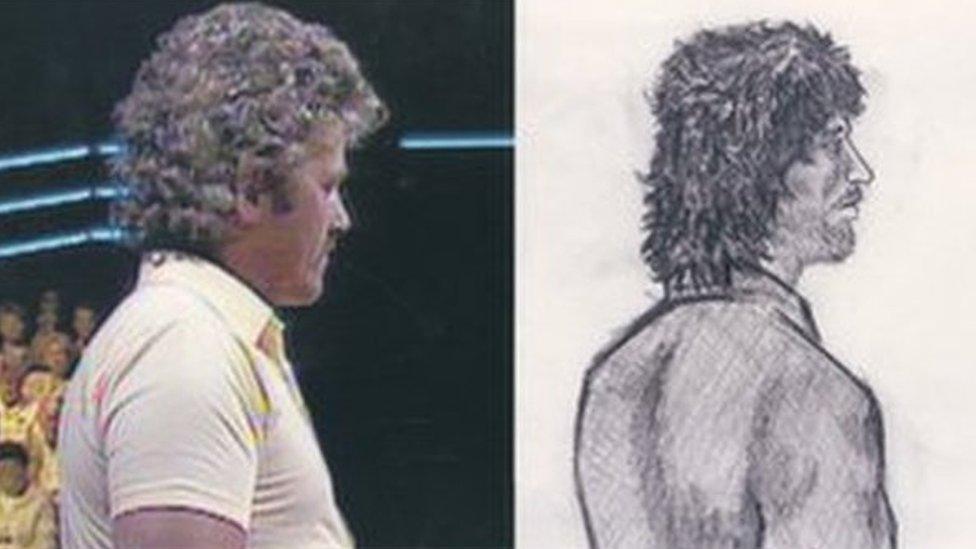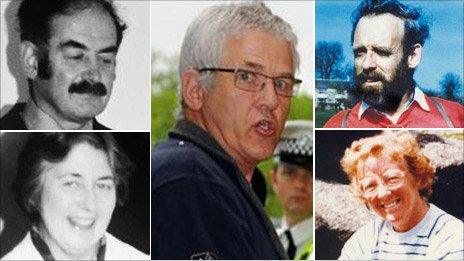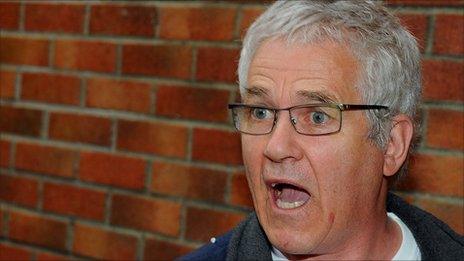John Cooper: Pembrokeshire murderer requests review of convictions
- Published

Cooper was handed a whole life prison term
A man who was jailed for life for murdering four people has requested a review of his convictions.
John William Cooper, 78, was found guilty of the 1985 murder of a brother and sister, as well as killing a husband and wife in 1989.
His appearance on TV quiz Bullseye was used during his trial to compare him to a sketch of a murder suspect.
The Criminal Cases Review Commission (CCRC) said on Monday it had received an application to review the case.
The CCRC, the independent body that reviews potential miscarriages of justice, is the last line of appeal open to anybody who thinks they have been wrongfully convicted.
It has the power to obtain information from public bodies to further investigate claims of wrongful conviction.
Cooper has always denied any involvement in the 1985 murders of siblings Richard and Helen Thomas in Milford Haven, and Oxfordshire couple Peter and Gwenda Dixon in 1989.
Following his conviction at Swansea Crown Court for the two double murders in 2011 Cooper was sentenced to a whole life minimum tariff.
He famously appeared on the Bullseye programme only a month before he murdered the Dixons.
Footage of his appearance on the show was shown in court during the trial to compare his likeness to that of a man seen using Peter Dixon's cash card on the day of his murder.
The cold case review which led to Cooper's conviction has also been turned into a three-part drama mini series on ITV called The Pembrokeshire Murders, featuring Hollywood actor Luke Evans.
Cooper was described in court by the judge as a "very dangerous man, highly predatory who, but for advances in forensic science, may well have continued to evade capture".
He was also found guilty of further offences including rape, indecent assault and four counts of attempted robbery.
His appeal in 2012 was rejected.

Cooper's trial in 2011 was shown a clip of him appearing on TV gameshow Bullseye and an artist's impression of a suspect
The CCRC will only consider cases if there is new evidence, not known at the time of the trial, or a new scientific development.
A case will only be referred for appeal if the new information is convincing enough that it raises a real possibility that the appeal court will overturn the conviction.
If the CRCC backs the application, the case can be sent back to the Court of Appeal.
The details of Cooper's application to the CCRC have not been disclosed.
Cold case review
Cooper was convicted in 2011 in relation to three separate incidents.
Richard and Helen Thomas were blasted to death with a shotgun at their home, Scoveston Park near Milford Haven a few days before Christmas in December 1985, before their home, Scoveston Park, was set on fire.
In June 1989, Peter and Gwenda Dixon from Oxfordshire were shot at close range on the coastal path near Little Haven. They had been camping nearby at Howelston Caravan Park, and were preparing to return home, when they were killed.

Siblings Helen and Richard Thomas were murdered by Cooper in 1985
All were killed with a double-barrelled shotgun.
In March 1996, five teenagers were threatened by a man wielding a shotgun and wearing a balaclava near the Mount Estate in Milford Haven. He raped a 16-year-old girl at knifepoint and indecently assaulted a 15-year-old girl.
Cooper was found guilty of the offences following a cold case review set up by Dyfed Powys Police in 2006 called Operation Ottawa.
Cooper had been convicted in 1998 of 31 offences of burglary and robbery and sentenced to 16 years in prison during the Huntsman investigation.
During the course of that investigation, police began to suspect he may be linked to the two unsolved double murders in Pembrokeshire and there were evidential links between exhibits gathered during the Huntsman investigation and the two double murders.

Gwenda and Peter Dixon had been camping when they were murdered
New forensic tests on exhibits gathered during the Huntsman investigation pointed to Cooper as the double shotgun killer and sex attacker.
Traces of blood shown to be Peter Dixon's were found on a shotgun owned by Cooper, thrown into a hedge after a failed armed robbery in November 1996.
Traces of Mr Dixon's blood were also discovered on a pair of shorts worn by Cooper, found in his house.
During the trial, he was depicted as an outdoorsman who used hedgerows as "safes" to hide the valuables he stole and to discard items. He also cut escape routes through fences and fields to evade police.
Significant fibre evidence also linked Cooper to the two double murders and other offences.

Hollywood star Luke Evans (left) played former Det Supt Steve Wilkins in the TV drama
There were also strong textile-fibre links with the two girls who had been sexually assaulted in Milford Haven.
These included fibres found on the inside of the girls' clothing that could have come from a pair of gloves discovered in a hedgerow discarded during a robbery and other fibres transferred in the reverse direction, from the clothing to the gloves.
Cooper's home had been thoroughly searched as part of the investigations into the burglaries and the robbery, and a number of items were removed from both inside and outside his home. Other items, including jewellery and gloves, had been recovered from hedgerows in the local area.
Dyfed-Powys Police said: "We have been advised that an application for an appeal against conviction has been lodged by John Cooper with the Criminal Cases Review Commission (CCRC).
"HDPP will comply with our obligations in any judicial process, but consider it inappropriate to provide specific comments relating to the application made by John Cooper at this time."
Related topics
- Published26 May 2011

- Published26 May 2011
